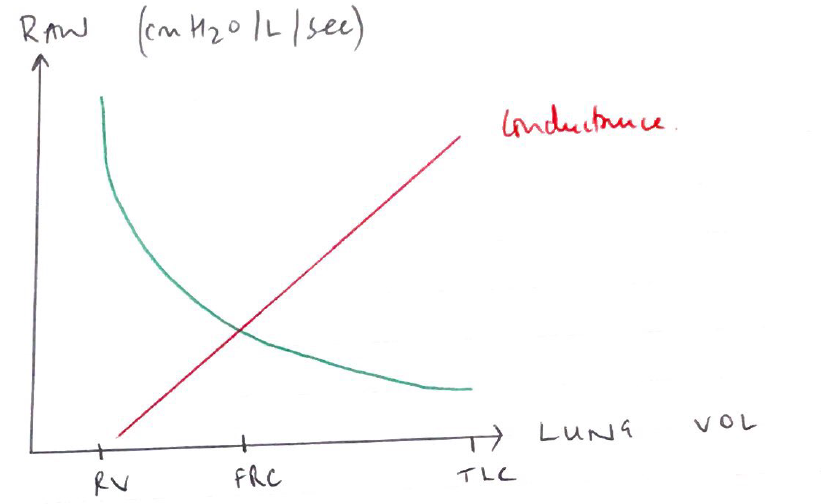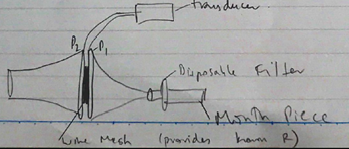F3viii 21B12 / 16B06: Airway resistance
21B12: Exam Report
Explain the physiological factors that affect airway resistance
31% of candidates passed this question.
It was expected candidates cover the breadth of the factors that affect airway resistance. Generally, as a concept the type of flow (laminar vs turbulent) was answered well by most candidates, however many failed to mention the other factors that affect airway resistance. Airway diameter as a primary determinant of airway resistance was commonly omitted. Better answers which covered the factors affecting airway diameter classified them broadly and included examples such as physical compression/external obstruction, broncho-motor tone and local cellular mechanisms. Some answers did not explain these factors in enough detail and often with incorrect facts.
16B06: Exam Report
Describe the factors that affect airways resistance.
47% of candidates passed this question.
Candidates who used a structured approach of using formulae that describe resistance fluid flow scored well. Poiseuille’s law describes the determinates of resistance to laminar fluid flow and provides a useful answer structure. The most common mistakes were confusion between resistance and compliance as well as failure to describe turbulent as well as laminar flow.
F3viii / 21B12 / 16B06: Describe factors that affect airway resistance.
Facts
- Normal RAW = 0.5 – 2cm H2O/L/sec
- Majority RAW in bronchi gen 7 – 8
- Although further airway generations are smaller in diameter, their total cross-sectional area is huge
- Respiratory System Resistance is due to:
- TISSUE RESISTANCE
- AIRWAY RESISTANCE
Tissue Resistance
- 20% of Respiratory System Resistance
- Due to friction of lung parenchyma as the tissues slide over each other
Airway Resistance
- The forces which have to be overcome for gas to flow in the airways
- Influenced by:
- Properties of inspired gas (viscosity + density)
- Type of flow (influenced by Reynold’s No.)
- Airway Calibre
- Lung volume
1) Properties of Inspired Gas
- Behaviour of gas in flow depends on 2 intrinsic properties of the gas:
- DENSITY = the ratio of mass to volume
- VISCOSITY = internal property of fluid which is a measure of resistance to flow
- Density & viscosity of gas are related to Airway Resistance (RAW) through the HP equation & Reynold’s No.
2) Type of Flow
- Flow = the volume of fluid (gas or liquid) passing a point in unit time
Laminar Flow
- Particles of fluid flow in parallel lines
- Flow greatest at centre
- Described by Hagen-Poiseuille equation
V = flow
h = viscosity
L = length
- Viscosity dependent (density independent)
- Very efficient because ∆P varies directly with flow
- Present in smooth tubes with low flow rates g. anaesthetic circuit
Turbulent Flow
- Disorganised air flow moving in the same direction
- More likely at high flow rates
- Density dependent (viscosity independent)
- Flow is not described by HP equation ∴Fanning Equation
- It is less efficient because ∆P varies directly with V2
- For a given flow, the necessary driving P is greater
- The driving P is also proportional to the 5th power of tube radius
Transitional Flow
- Flow is neither fully turbulent nor fully laminar
- There is a gradual transition from laminar → turbulent
Reynold’s Number
- A dimensionless number used to determine if flow is going to be laminar or turbulent
- Low (<2000) = laminar flow because viscous forces predominate = smooth, consistent fluid motion
- High (>2000) = turbulent flow = random eddies, vortices, flow fluctuations = dominated by inertial forces
3) Airway Calibre
- All types flow affected by airway calibre
- ↓radius of airway = ↑RAW
- Calibre affected by:
- Intraluminal factors
- Tumor
- Foreign Body
- Intramural factors:
- Mainly affected by bronchial smooth m. tone
- Drugs
- Adrenergic = bronchodilation
- Cholinergic = bronchoconstriction
- Innervation
- Parasymp = bronchoconstriction
- Symp = poorly innervated lung
- MC products
- Bronchoconstriction
- Extraluminal factors
- Kinking ETT
- Intraluminal factors
Measurement of Airway Resistance
- P1 = mouth pressure → measured with manometer
- P2 = alveolar pressure → body plethysmography
- Body plethysmograph measures total volume of gas in lungs
- Uses: BOYLE’S LAW: P x V is constant (at constant temp)
∴P1V1 = P2(V1 – ∆V)
- ∴to deduce alveolar P:
- On INSP ↑alveolar V & ↓alveolar P
- ∆P in the body plethysmograph box
- Can calculate the ∆ volume & deduce the alveolar P
- ∴to deduce alveolar P:
- Flow rate → measured with Pneumatochograph
- Flow is derived from the pressure difference calculated against a known small resistance
If you blow into mouthpiece (with known Resistance) P1 & P2 are deduced and Flow can be calculated
- Author: Krisoula Zahariou



